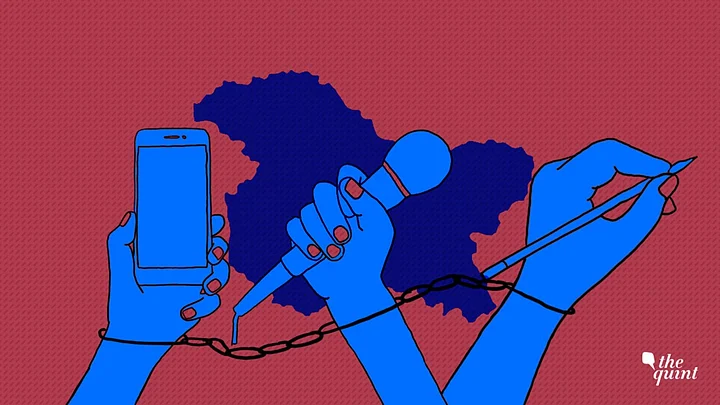A day after the abrogation of the Article 370, Shahid Nabi (name changed) came to interview a prominent leader of a Kashmir-based party at his upscale residence on Srinagar outskirts.
Upon arriving in the area, he found a large posse of police and paramilitary forces guarding the residence, who were turning away a small group of people wanting to meet the leader, a former J&K Cabinet minister.
“I hit upon an idea and bought some groceries. When the guards at the gate stopped me, I told them that I had come from his constituency. Seeing the groceries in my hand, they allowed me entry. It was a brief meeting but my work was done,” Nabi, a freelance journalist based in Srinagar, told The Quint.
For media, these are hard times in Kashmir. In the past, authorities used to block mobile internet services in the Valley whenever there were fears of law and order breakdown but landlines and broadband services used to work normally, allowing media to carry on its work unhindered.
Not anymore!
For journalists who troop into Srinagar from all corners of the country these days as well as local newsmen, the prevailing communication blockade has restricted their reportage to the four walls of the state’s media centre where official briefings are held, twice in a day, to feed the daily news cycle.
So when the young male coordinator of the state’s information department, which organises the daily briefings at a private hotel in Srinagar, gleefully announced at the media centre on Saturday evening, 18 August, that there will be only one briefing next day, it was received with much consternation inside the large hall packed with journalists.
“Please don’t say that! What will we do here through the day?” one video-journalist working with a national broadcaster said with a tinge of sadness.
A reporter who works for a local English daily in Srinagar sitting next to me, sighed in relief. “At least there will be one briefing, otherwise what will we write? If they do away with these briefings, we may well end up losing our jobs,” he said, sarcastically.
Losing The Narrative
While the abrogation of the special status and its political ramifications is clearly the biggest story, most of the national media has occupied itself in looking at Kashmir through the national security prism, yet again.
Some honourable exceptions apart, the big Kashmir story on national media and particularly TV media is that ‘normalcy’ is gradually returning and restrictions on civilian movement and communication systems are being eased out steadily.
“If no civilian has died in this crisis, then surely it is a big achievement of the government. Also, fewer protests have happened this time around. I think it will take some time for situation to settle,” a journalist from Rajasthan who works with a national Hindi daily and has been camping in Srinagar from four days said at the media centre.
I asked if he had managed to move out of Srinagar for some ground reporting. He replied in negative: “There are restrictions in place. It is safer here than on the ground,” he said, completely oblivious to the fact that hundreds of police and paramilitary troopers armed with riot gear and automatic weapons were ready to swing into action not just in Srinagar city but across the Valley.
For those willing to take the risk and set out on the adventure of moving out of the media centre, there is fear and hostility. Anger among ordinary people on the ground is borne less by the fact that J&K’s special status has been scrapped than the manner in which it was scrapped.
Information Black Hole
For local media owners, the going is getting tougher. The prevailing communication crisis has turned newspapers into ‘pamphlets of official briefings’ and wire news items. Out of nearly 150-odd newspapers, barely a dozen are publishing. No local news agency has been able to function since the Valley was put under siege.
“You don’t know about the happenings beyond Lal Chowk. Government is confined to official press conferences. There is problem in getting official version when communication is snapped, so it is better not to report at all than landing in trouble,” Samaan Lateef, who works for a national English daily, said.
Most journalists pool information about the ground situation from their experiences of commuting from homes and hotels to media centre and back. There is no way to contact sources, except to personally visit them with the hope of finding them.
“In initial days, we used to sit in front of TV and write whatever was being reported by the national media. The situation hasn’t changed much. We can only hope the communication networks are restored at the earliest,” Moazum Mohammad, who works as an editor with a local English daily, said.
In the absence of phone and internet connectivity, it is becoming difficult, almost impossible, to collect and verify information about the happenings on the ground.
“What we report is only based on official version. There is no way to corroborate or verify the information given out by officials. The situation has turned us into stenographers of the official machinery,” a senior journalist who works with a national broadcaster based in the national capital, said.
(Jehangir Ali is a Srinagar-based journalist. He tweets at @gaamuk.)
